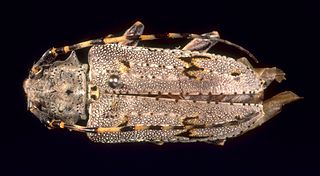Related Research Articles

The insects of the beetle family Chrysomelidae are commonly known as leaf beetles, and include over 37,000 species in more than 2,500 genera, making up one of the largest and most commonly encountered of all beetle families. Numerous subfamilies are recognized, but the precise taxonomy and systematics are likely to change with ongoing research.

The longhorn beetles (Cerambycidae), also known as long-horned or longicorns, are a large family of beetles, with over 35,000 species described.

The Chrysomeloidea are an enormous superfamily of beetles, with tens of thousands of species. The largest families are Cerambycidae, long-horned beetles, with more than 35,000 species, and Chrysomelidae, leaf beetles, with more than 13,000 species.

Osmoderma is a genus of beetle in family Scarabaeidae. It contains the following species:

Spondylidinae are a small subfamily of Cerambycidae including slightly over 100 species, primarily in the coniferous forests of the Boreal hemisphere. A few species occur in coniferous forests in tropical and subtropical areas, while very few genera are present in Austral Africa and Madagascar. Some sources spell the name as Spondylinae.
Acmaeopsoides rufula is a species of beetle in the family Cerambycidae, and the only species in the genus Acmaeopsoides. This beetle is distributed in Canada, and United States.

Clytini is a tribe of beetles in the subfamily Cerambycinae, containing the following genera:

Aegomorphus morrisi is a species of beetle in the family Cerambycidae. It was described by Uhler in 1855. The species name is often misspelled as morrisii (e.g.) but this spelling is not in prevailing usage and the original spelling is therefore valid under ICZN Article 33.4.
Vitalisia is a genus of grasshoppers in the subfamily Acridinae, with no tribe assigned. Two species have been recorded from Indochina from Bangladesh to peninsular Malaysia.
Carenum brevipenne is a species of ground beetle in the subfamily Scaritinae, found in Australia. It was described by William John Macleay in 1887.

Rhytiphora bankii is a species of beetle in the family Cerambycidae. It was first described by Johan Christian Fabricius in 1775, under the genus Lamia. It is known from Australia, the Philippines, Borneo, Java, Micronesia, New Guinea, Hawaii, Moluccas, Sumatra, Vietnam, and has been introduced into Japan. The Australian species of Prosoplus were synonymised with Rhytiphora in 2013.
Nanophyllium brevipenne, is a species of phasmid or leaf insect of the genus Nanophyllium. It is found in New Guinea, and Sri Lanka.

Omalium rugatum is a species of rove beetles native to Europe.
Dropephylla is a genus of rove beetles.

Aulocara is a genus of slant-faced grasshoppers in the family Acrididae. There are at least three described species in Aulocara.

Spathosternum is a genus of grasshoppers in the family Acrididae: subfamily Spathosterninae, with species found in Africa, including Madagascar and tropical Asia.

Cornops is a genus of spur-throat toothpick grasshoppers in the family Acrididae. There are about six described species in Cornops.

Nanophyllium is a genus of leaf insects comprising 11 species, found in Australia, Papua New Guinea, Southern Indonesia, and the Indian Subcontinent. Not much is known about this genus, primarily due to their remote habitats and elusive appearance.
References
- ↑ Bezark, Larry G. A Photographic Catalog of the Cerambycidae of the World
- ↑ TITAN database
- ↑ Linsley, E.G. (1964) The Cerambycidae of North America. Part V. Univ. of California Publications in Entomology, vol. 22.
- ↑ BugGuide: Megacheuma brevipenne